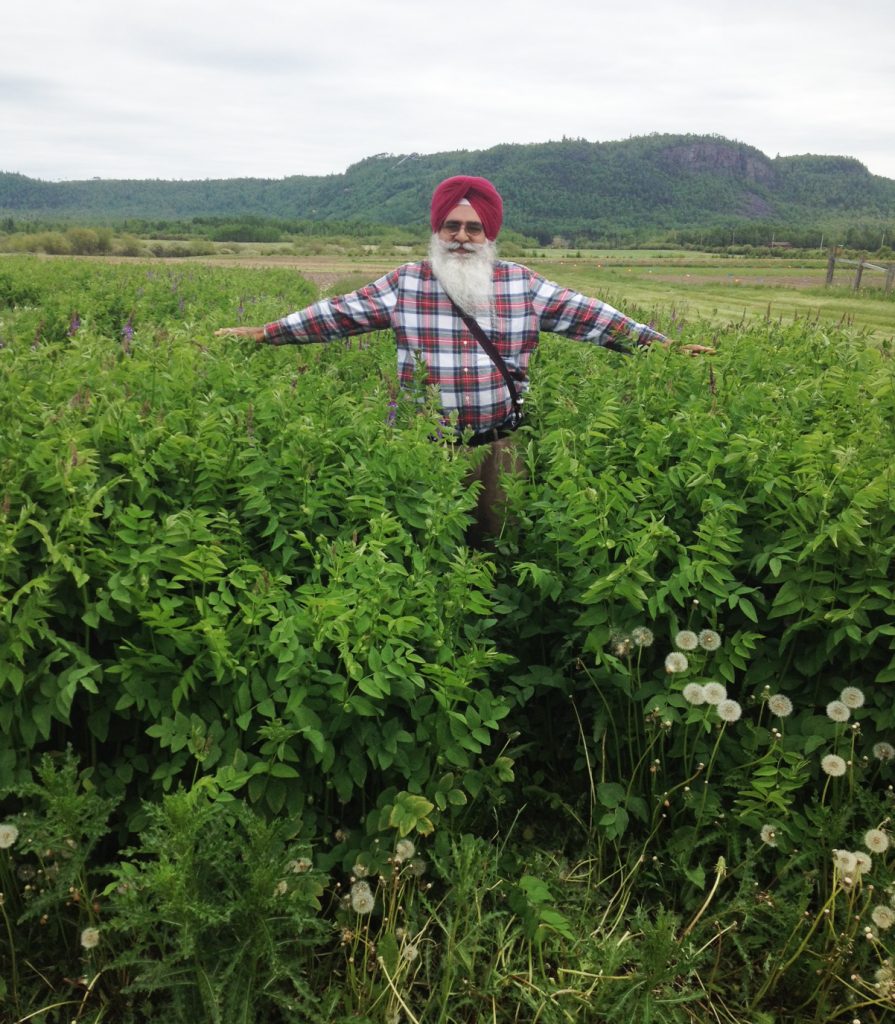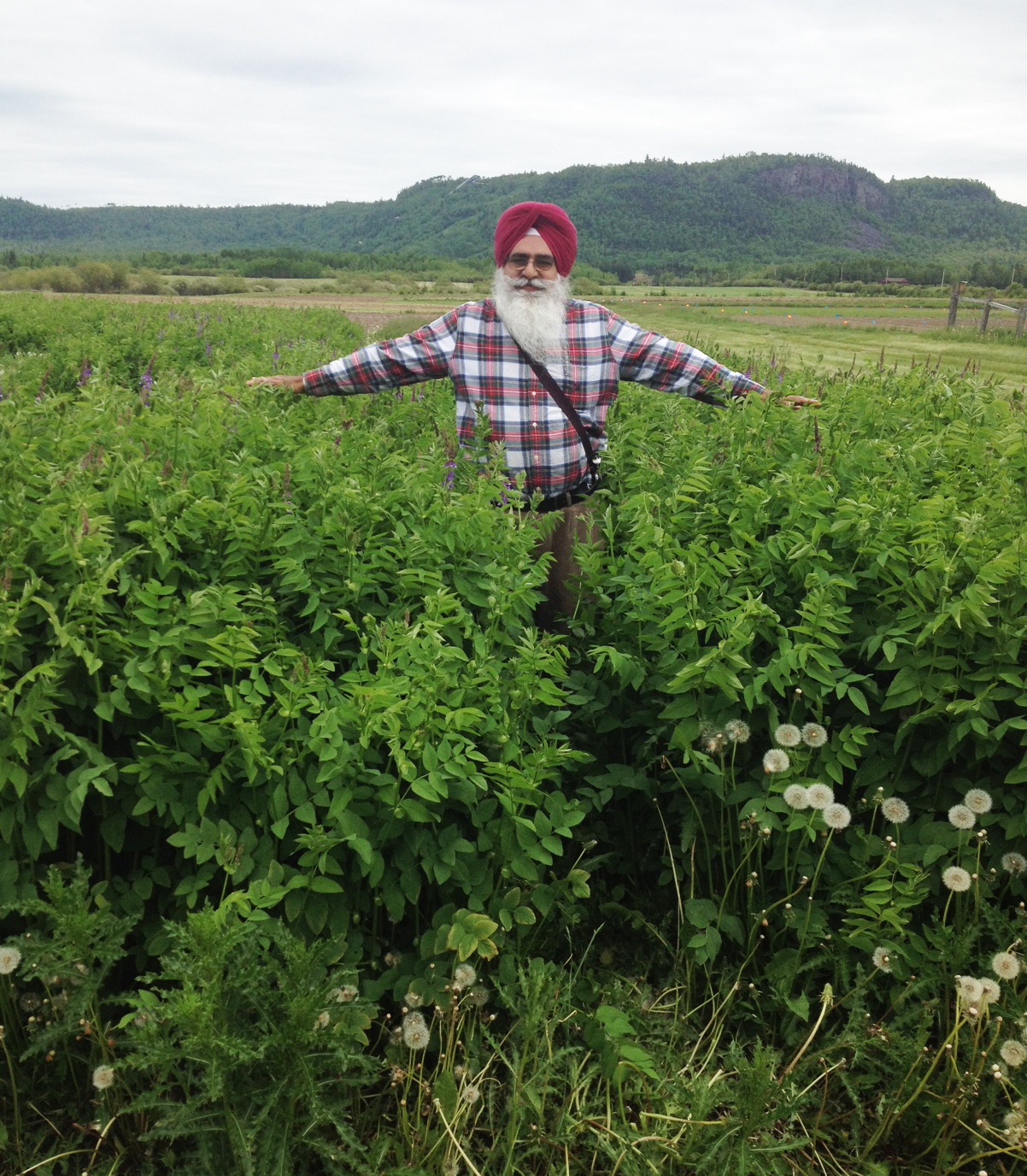 Galega, also called oriental goat’s rue, is a perennial forage legume from the Scandinavian countries. It outperformed alfalfa in forage dry matter yield, feed quality, dandelion suppression, winter hardiness and persistence in multi years research at the Thunder Bay Agricultural Research Station (TBARS) Thunder Bay (www.tbars.net); read more at: http://www.country-guide.ca/2016/03/24/galega-a-new-forage-import-from-eastern-europe/48608/.
Galega, also called oriental goat’s rue, is a perennial forage legume from the Scandinavian countries. It outperformed alfalfa in forage dry matter yield, feed quality, dandelion suppression, winter hardiness and persistence in multi years research at the Thunder Bay Agricultural Research Station (TBARS) Thunder Bay (www.tbars.net); read more at: http://www.country-guide.ca/2016/03/24/galega-a-new-forage-import-from-eastern-europe/48608/.
I came to know about this wonderful legume that can fix atmospheric nitrogen into the soil from Dr. Jason Koivisto in 2005-’06. Koivisto now with the Ministry of Natural Resources was the Agricultural Development Adviser, Ministry of Northern Development and Mines then. He arranged to get Galega seeds for John Rowsell (retired since the past few years), the then Manager at the New Liskeard Agricultural Research Station (NLARS), and me/TBARS. We compared Galega with alfalfa in systematic field experiments at both the locations from 2006-’09 and found that Galega equaled in dry matter yield with alfalfa at New Liskeard, but gave only ~90 % of the alfalfa dry matter yield at TBARS, where the forage quality from Galega (higher protein content, somewhat lower ADF, bit higher TDN and higher energy values and mineral nutrients except calcium and boron) was better than alfalfa. In this study, we had used a seed rate of 20 kg/hectare. Anyone else in my place may have concluded that the Galega because of its lower yield than alfalfa is not worth for further research. Intuitively, I felt that the seed rate we tried was lower than normal and we need to try higher seed rate. Therefore in the field experiments from 2011 onwards, we compared Galega @ 25, 35 and 45 kg seed rate per hectare with alfalfa at its recommended seed rate and we found that:
- 25 kg seed rate/hectare was optimum for forage production in the short to medium term and a seed rate of 35 kg/hectare was optimum for longer term Galega production (more than 3-4 years).
- Due to its early start in the spring, Galega was ready for harvesting a week before alfalfa.
- Dry matter yield gain from Galega over three harvest years (2012-’14; total 6 cuts) as compared to alfalfa was 2,630 kg/ha, which amounts to ~880 kg/ha/year (higher yield than alfalfa).
- Protein content in first cut Galega was 26.1 % (up to 4.1 % point higher than that in alfalfa). In the second cut, there was no difference in the protein content in the two crops (little over 20 %).
- Dry matter yield spread was 55 % in the first cut and 45 % in the second cut; more or less the same as in alfalfa.
Seeing the bumper Galega crop at TBARS (see attached picture in which Dr. Sahota is seen in the Galega plots at TBARS), Peter Aalbers, a local dairy producer (807-935-1644) seeded Galega in 40 acres in 2015. Harvest in 2016 (see attached picture) indicated that Galega gave significantly higher yield in the first (6 extra loads; each load equals ~6 MT) as well as second cut (one additional bale/acre; one bail = 900 kg) than the side by side alfalfa with the same acreage. Aalbers is planning to add another 60 acres to his Galega plantation next year, because he is short of acres this year. Aalbers, I believe, has created history by becoming the first Galega grower in Ontario!
Thunder Bay Feeds, a local agri retail business (807-935-2921), has managed to import 4 MT seeds of Galega (enough to seed 400 hectares = 1,000 acres). He has got seed orders from some 15 farmers as follows:
Thunder Bay: 5 farmers
Dryden: 4 farmers
Rainy River: 3 farmers, and
Areas close to GTA: 3 farmers.
In addition, an agri firm at Guelph had imported Galega seed (= 50 acres seeding) last year and I have had queries about the crop/and its seed from Quebec and Saskatchewan.
Assuming that Galega expands to 10,000 acres in Ontario in the next few years; gain from its additional yield as compared to alfalfa could mean $3,872,000.00 and dollar value from additional protein content in Galega compared to alfalfa could be 1,673,945.00 (based on a hay value of $110.00/MT and $44.44/kg protein).
TBARS thankfully acknowledges funding support from NOHFC and OMAFRA and support from farmers, public at large, the media and two of our local MPPs, Bill Mauro and Michael Gravelle for continued support to the Development Oriented Research at TBARS Thunder Bay.
Contact:
Tarlok Singh Sahota Ph.D. CCA
Director of Research and Business
Thunder Bay Agricultural Research Station
435 James St South, Suite B012
Thunder Bay, ON P7E 6S7
Phone: 807 473 5707 Fax: 807 475 8404
Email: tarloksahota@tbaytel.net
Website: www.tbars.net
Past President Canadian Society of Agronomy
Adjunct Professor, Lakehead University Thunder Bay

